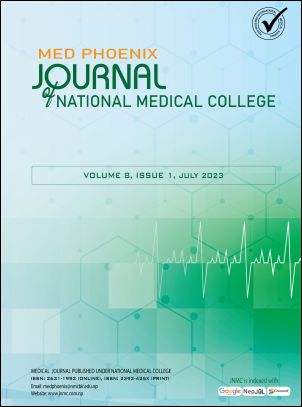Diprosopus Tetrophthalmus Including Radiological and Post-Partum Images- A Case Report
DOI:
https://doi.org/10.3126/medphoenix.v8i1.56839Keywords:
conjoint twin, diprosopus tetrophthalmus, monocephalicAbstract
Introduction: Conjoint twinning is very uncommon with an incidence of approximately 1:50,000 to 1:100,000. Diprosopus tetrophthalmus is the rarest variant of conjoined twinning which results from incomplete monozygotic, monochorionic and monoamniotic twin division associated with multiple congenital malformations. A 25 years old female patient at 26 weeks of gestation having single gravida (primi) and no significant family history was referred to our radiology department for anomalies scan. Transabdominal obstetric ultrasound showed the fetus with one head, two faces, two legs, two hands, one thorax, one abdomen and a single spinal cord with deformed spine. The aim of this case report was to present and discuss a case of Diprosopus tetrophthalmus (craniofacial duplication) a rare variant of conjoined twins resulted from incomplete monozygotic, monochorionic and monoamniotic twin division which help in prenatal counseling to the patient and its management.
Downloads
Downloads
Published
How to Cite
Issue
Section
License
Copyright (c) 2023 Med Phoenix

This work is licensed under a Creative Commons Attribution 4.0 International License.
This license enables reusers to distribute, remix, adapt, and build upon the material in any medium or format, so long as attribution is given to the creator.
Copyright on any research article is transferred in full to MED PHOENIX upon publication. The copyright transfer includes the right to reproduce and distribute the article in any form of reproduction (printing, electronic media or any other form).




